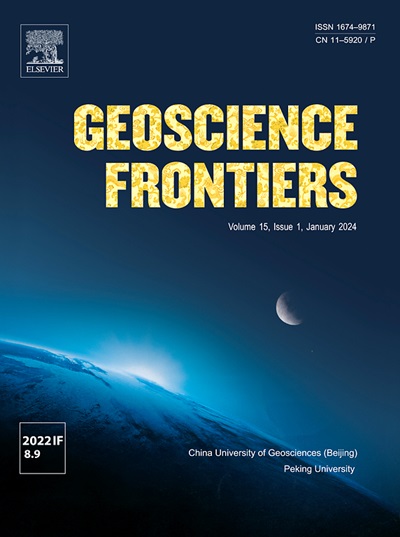Provenance of a Stenian succession in the eastern Jiangnan (Sibao) Orogen, South China: Implications on tectonic affinity and pre-Neoproterozoic crustal evolution
IF 8.9
1区 地球科学
Q1 GEOSCIENCES, MULTIDISCIPLINARY
引用次数: 0
Abstract
The Lower Tieshajie Subgroup at the conjunction zone of the Yangzte and Cathaysia blocks represents the only Stenian sedimentary succession in the eastern Jiangnan (Sibao) Orogen of South China, bearing important clues on plate boundary and pre-Neoproterozoic crustal evolution. We report the first U-Pb and Hf isotopic data of detrital zircons from this succession to investigate the age and provenance characteristics. Age and Hf isotopic compositions of detrital zircons from the lower and upper parts of the metamorphosed Lower Tieshajie Subgroup are similar. They are exclusively of magmatic origins, showing youngest age peaks at ca. 1.17 Ga and ca. 1.15 Ga, respectively, but both with a rarity of 1.12–1.10 Ga ages from the nearby magmatic rocks. This constrains protolith deposition of the Lower Tieshajie Subgroup to be mainly at 1.17–1.12 Ga, while the timing of metamorphism is bracketed by the intruding unmetamorphosed granites to be 1.10–0.84 Ga, that is, related to Grenville-aged orogenesis at the Jiangnan Orogen. The detrital zircons yielded a broad age range of 3.28–1.03 Ga, dominated by a 1.20–1.10 Ga population interpreted to be sourced from coeval magmatic rocks within the Tieshajie Complex itself. The abundant Archean and Paleoproterozoic detrital zircons are well-matched with magmatic records from the Eastern Yangtze Block, suggesting a Yangtze Block affinity of the Lower Tieshajie Subgroup. This implies that the surface boundary between the Yangtze and Cathaysia blocks is located to the south of the Lower Tieshajie Subgroup, probably in between the two parts of the Tieshajie Group. Age peaks of detrital zircons at 2.85–2.78 Ga, 2.68 Ga, and 2.50 Ga, combined with regional data, suggest episodic magmatism involved both crustal growth and reworking during the late Archean in the Jiangnan Orogen and adjacent areas of the Eastern Yangtze Block, while the 2.10–1.80 Ga peak corresponds to significant reworking of pre-existing crust related to the early assembly of the Nuna (Columbia) Supercontinent. Regional correlations based on detrital zircon age spectra and tectono-magmatic histories show similarities between the Yangtze Block and North India, suggesting the two continents were likely in spatial proximity at least during the late Mesoproterozoic to Neoproterozoic time.

华南江南(四宝)造山带东部斯坦系序列物源:构造亲和与前新元古代地壳演化意义
扬青—华夏地块结合带的铁沙街下亚群是华南江南(四堡)造山带东部唯一的斯坦系沉积序列,为板块边界和前新元古代地壳演化提供了重要线索。本文首次报道了该序列碎屑锆石的U-Pb和Hf同位素数据,探讨了其年龄和物源特征。变质下铁沙街亚群上下段碎屑锆石年龄和Hf同位素组成相似。它们完全是岩浆起源,显示最年轻的年龄峰值分别为约1.17 Ga和约1.15 Ga,但两者都罕见地来自附近的岩浆岩1.12-1.10 Ga。这限制了铁沙街下亚群原岩沉积主要在1.17 ~ 1.12 Ga,而变质作用的时间被侵入的未变质花岗岩所包围,为1.10 ~ 0.84 Ga,与江南造山带格伦维尔-古造山作用有关。碎屑锆石的年龄范围为3.28 ~ 1.03 Ga,其中以1.20 ~ 1.10 Ga的锆石群居多,这些锆石可能来自铁沙街杂岩内部的同古岩浆岩。太古宙和古元古代丰富的碎屑锆石与东扬子地块的岩浆记录匹配良好,表明下铁沙街亚群与扬子地块有亲缘关系。这表明扬子地块与华夏地块的表面边界位于下铁沙街亚群的南部,可能位于铁沙街群的两个部分之间。结合区域资料,2.85 ~ 2.78 Ga、2.68 Ga和2.50 Ga的碎屑锆石年龄峰值表明,江南造山带及东扬子地块邻区晚太古代岩浆活动既参与了地壳生长,也参与了地壳改造,而2.10 ~ 1.80 Ga的年龄峰值对应了与努纳(哥伦比亚)超大陆早期组装有关的已有地壳的重大改造。基于碎屑锆石年龄谱和构造-岩浆历史的区域对比显示,扬子地块与北印度大陆具有相似性,表明至少在中元古代晚期至新元古代时期,两个大陆可能处于空间接近状态。
本文章由计算机程序翻译,如有差异,请以英文原文为准。
求助全文
约1分钟内获得全文
求助全文
来源期刊

Geoscience frontiers
Earth and Planetary Sciences-General Earth and Planetary Sciences
CiteScore
17.80
自引率
3.40%
发文量
147
审稿时长
35 days
期刊介绍:
Geoscience Frontiers (GSF) is the Journal of China University of Geosciences (Beijing) and Peking University. It publishes peer-reviewed research articles and reviews in interdisciplinary fields of Earth and Planetary Sciences. GSF covers various research areas including petrology and geochemistry, lithospheric architecture and mantle dynamics, global tectonics, economic geology and fuel exploration, geophysics, stratigraphy and paleontology, environmental and engineering geology, astrogeology, and the nexus of resources-energy-emissions-climate under Sustainable Development Goals. The journal aims to bridge innovative, provocative, and challenging concepts and models in these fields, providing insights on correlations and evolution.
 求助内容:
求助内容: 应助结果提醒方式:
应助结果提醒方式:


